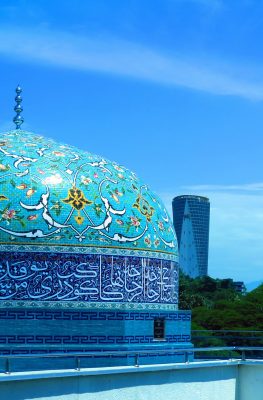Published on January 27, 2015

As Indonesia counts a large population of those with Chinese descent, most of whom have lived here for generations, Chinese New Year – here known as Imlek – is celebrated with lots of fanfare in many townships across the archipelago. Chinese New Year has also been declared a national holiday, which this year falls on 19 February 2015. While celebrations continue for 15 days culminating on 5 March , known as Cap Go Meh.
On New Year’s eve, Chinese families whose members may be living far apart, make it point to gather at New Year’s eve family dinner. The next morning they will all go to the temple to pray and burn incense and joss sticks. Preparing for this auspicious occasion, temples have been spruced up and decorated with red lanterns and huge red candles. During the two weeks celebrations, groups of lion dancers prance around the city accompanied by loud drums and cymbals. In response, people give red packets of money or ang pao in its mouth, to receive good luck from the lions. Meanwhile at parades, athletic dancers carry colorful “dragons” zig-zaging along the streets that are crowded with onlookers.
In the city of Semarang, capital of the province of Central Java,- where Chinese Imperial Emissary Admiral Zheng He (here better known as Cheng Ho ) first set foot on Java, – its Chinatown known as Pasar Semawis is crowded when the annual Pasar Imlek or Chinese New Year market is held here from 4-16 February selling decorations, special New Year clothes, knick-knacks and foodstuff for families to prepare for the big day. Then the market is transformed into a festive arena where open air stages are set for performances along Gang Pinggir and Srawung, held from 14-17 February. Here the public can enjoy typical Chinese dances, music and cultural performances like the Wayang Potehi, Gambang Semarang, Twa Kok Djwee, barongsai, toya games and even Wushu.
Meanwhile in the city of Solo, also in Central Java, Chinese New Year is celebrated around Pasar Gede Market near the Tien Kok Sie temple. Both Chinese descendants as well as locals celebrate together starting with the traditional Javanese Grebeg Sudiro held from15-18 February, just prior to Chinese New Year celebrations which falls on 19 February. At the pinnacle of Grebeg Sudiro people are encouraged to grab vegetables and fruits from the cone-shaped mountain of produce that are piled up high, and which has earlier been paraded around town. The tradition of grabbing and even fighting for a piece of produce is based on the Javanese teaching that says : ora babah ora mamah, meaning there is no food without struggle.
Along with the Grebeg Sudiro tradition, a series of events will also highlights the Chinese New Year celebration in Solo, including:The million Lanterns fiesta from 30th January to 18th February; cleaning the banks of the Pepe river and planting medicinal plants on 1st February 2015; the Umbul Mantram Ritual and the Pepe River Decorated Boats on 5thFebruary; Grebeg Sudiro Cultural Carnival on 15th February; Release of lanterns and Firework Fiesta on 18thFebruary; Barongsai (Lion Dance) and Liong (Dragon Dance) Parade on 5th March; and the Official “Imlek” Chinese New Year Ceremony of Solo City at Pendhapi Gedhe, the City Hall of Solo on 5th March 2015.
As expression of sympathy for victims of recent misfortunes that occurred in several places including the fire that burnt the traditional Pasar Klewer Market in the city, this year the Solo Imlek Festival will not take place.
Meanwhile, in neighboring Yogyakarta, this Chinese New Year celebration promises to be even more festive. Named the Chinese Cultural Week the event is held from 1-5 March 2015 in conjunction with Cap Go Meh. Carrying the theme: Knitting together Cultures, Creating Unity, people will be shown the acculturation of Chinese heritage into Javanese life. Throughout the week there will be exhibitions, Mandarin language competitions, karaoke sessions at Kampung Ketandan, and more fun, music and dance extending to the Suryatmajan arterial road.
Meanwhile, in the mountain cities of Bandung and Sukabumi in West Java, people will also not pass Chinese New Year without celebrations with the mandatory lion and dragon dances along busy streets, of course after morning prayers at the temples.
In Jakarta, capital of Indonesia, Chinese New Year is celebrated around China town, at around Petak Sembilan and Glodok area, where stands the Yin De Yuan temple, the oldest Chinesed temple in Jakarta built in 1650. Malls will be festooned with gay Chinese New Year decorations, and people will flock to restaurants to enjoy Chinese New Year meals with the whole family.
While, on the island of Sumatra, starting from the city of Medan in the North, the large Chinese population here will celebrate this year with the Gebyar Imlek Fair, – or the Chinese New Year Fiesta from 30 January to 8 February. Although Medan is known to have long been a favored port of call for Chinese merchant vessels since centuries, yet this year for its celebrations Medan has opted for the more trendy and modern, appealing to the youth. There will be rock, jazz and pop music, as well as fashion shows, modern dance festival and a cosplay festival. There will of course be an array of delicious spreads of seafood, a favorite of Medan.
In South Sumatra, the city of Palembang in the Dempo Chinatown, the Imlek Festival will be held from 28 February – 4 March, where people will be spoilt with a culinary exhibition and a number of competitions of traditional boats and dragon boat races.
Since Palembang was once the seat of the great Srivijaya kingdom, when Chinese merchants were wont to visit here and Buddhist scholars made this their place of sojourn and learning before proceeding to India, Palembang holds many traces of Chinese cultural heritage that can be seen from the architecture of houses, clothes, medicines, graves, and of course cuisine.
At Cap Go Meh a host of people take boats to the island of Kamaro where is an old Chinese temple, and a center for prayers at Chinese New Year.
On the islands of Batam and Bintan, just opposite Singapore, people will flock to the new huge Buddhist temples on Batam and near Tanjung Pinang on Bintan. Devotees will come not only from the hundreds of surrounding islands but also from Singapore and Malaysia.
But arguably the pinnacle of celebrations of Chinese New Year in Indonesia is the Cap Go Meh at Singkawang in West Kalimantan, known as the greatest Chinese New Year event in the region. This is because here the age-old tradition of tatung is still followed, when men, women and children will meditate, go into a trance then pierce themselves with sharp lances but strangely remain completely unharmed. These colorfully dressed tatungs are believed to ward off evil spirits and keep the city and the area safe from disasters and illnesses through the coming year. The parade of tatungs will take place on 5 March at Cap Go Meh, starting from Diponegoro road, pass Jalan Sejahtera, Budi Utomo, Setia Budi, finishing at Jalan Niaga.






